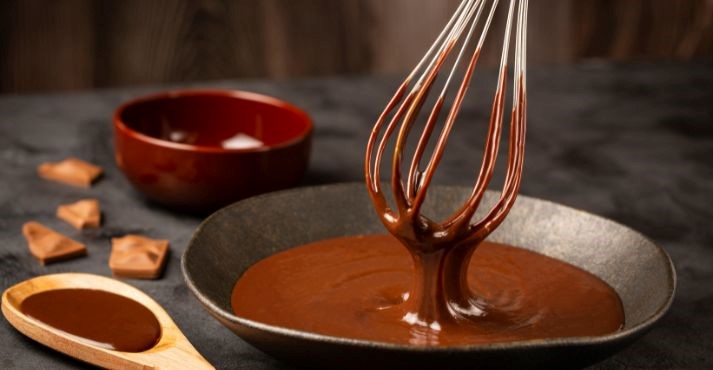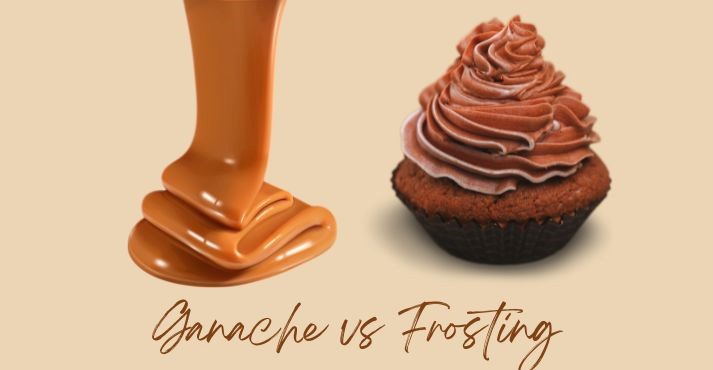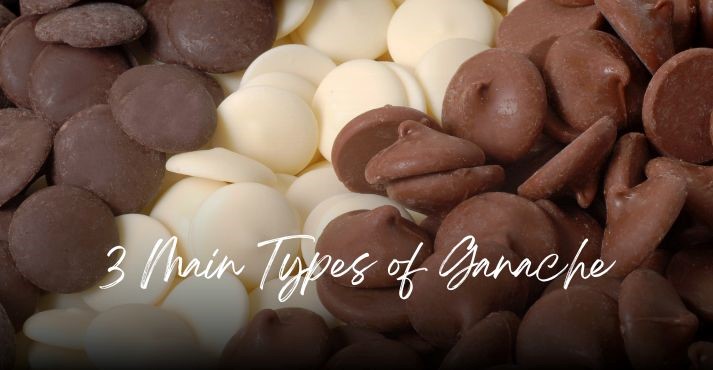Melted, whipped, drizzled, or spread, ganache makes it an irresistible topping to any dessert.
A simple mixture of chocolate and cream, ganache is the ingredient that makes all chocolate desserts taste more decadent and more luscious.
Ganache or crème ganache was originally a chocolate truffle introduced by the Paris playwright-turned-confectioner Paul Siraudin.
Ganache is very versatile. This blog will explore everything you need to know about ganache.
But first, let’s define ganache.
What is Ganache?

Ganache is a rich blend of chocolate (dark, milk, or white) and cream. It is a rich, velvety mixture of chocolate and cream. You can find ganache in various deserts, from truffles and tarts to frosting and cake fillings.
Do you know what ganache pronunciation is?
Pronounced “guh-nahsh,” this French-derived delight can serve as a glaze, filling, or frosting, with its consistency determined by the ganache ratios of ingredients.
Ganache Ingredients
The primary ingredients used in making ganache include chocolate and warm cream. Ganache’s proportions determine its consistency, yielding a glossy glaze, creamy filling, or thick frosting.
Premium chocolate is crucial, significantly influencing the final flavor and texture. Cream, typically heavy or whipping cream, brings a luscious consistency when heated and combined with chocolate.
The smooth texture and rich flavor make ganache a staple in chocolate, elevating the indulgence of chocolate-based creations. Some recipes may include butter for added richness and a glossy finish.
The precise ratio of chocolate to cream determines the ganache’s purpose—whether as a pourable glaze, soft filling, or firm frosting—showcasing its adaptability in crafting diverse, delectable desserts.
Whether drizzled over cakes, enrobing truffles, or adorning pastries, ganache adds a decadent touch and delighting palates worldwide.
Ganache vs. Frosting

Ganache can be used as a frosting, but their differences exist.
Ganache, with its chocolate and cream base, offers a rich, smooth, and glossy texture, perfect for glazes, fillings, or frostings with a luxurious taste. Traditional frosting, often sugar-based, tends to be sweeter and has a stiffer consistency, ideal for intricate decorations.
Consider the dessert’s nature—ganache for decadent richness and versatility and traditional frosting for a sweeter, structured finish. The choice depends on your dessert’s desired flavor profile, texture, and decorative requirements.
How to Make Ganache
Here’s the step-by-step guide to making ganache.
Ingredients:
- High-quality chocolate (dark, milk, or white)
- Heavy or whipping cream
- Optional: Butter, vanilla extract, liqueurs, or other flavorings
Steps to make a basic ganache:
- Chop chocolate finely and place it in a heatproof bowl.
- Heat cream in a saucepan over medium heat until it simmers (do not boil).
- Pour hot cream over chopped chocolate and let it sit for a minute.
- Stir gently until smooth and well combined.
- Optional: Add butter or flavorings, stirring until incorporated.
For different applications, you can use a combination of ratios of chocolate and creams.
- Pourable Ganache (Glaze): Ratio: 1:1 (equal parts chocolate and cream). Pour over cakes, pastries, or desserts for a glossy finish.
- Soft Ganache (Filling, Truffles): Ratio: 2:1 (chocolate to cream). Use it to fill cakes, truffles, or a soft layer between cake tiers.
- Firm Ganache (Frosting): Ratio: 3:1 or 4:1 (chocolate to cream). Whip-cooled ganache for a thicker consistency, ideal for frosting cakes and cupcakes.
Consider these tips for achieving the right consistency of the ganache:
- Use high-quality chocolate for the best flavor.
- Warm the cream before pouring it over the chocolate for more effortless blending.
- Stir gently to avoid incorporating air bubbles.
- Ganache can be reheated gently to adjust consistency if needed.
- Let the ganache set at room temperature or in the fridge, depending on your application.
3 Main Types of Ganache

There are three main types of ganache: dark chocolate, milk chocolate, and white chocolate.
Dark Chocolate Ganache
Dark chocolate ganache boasts an intense cocoa flavor using high cocoa content chocolate. Its rich and slightly bitter profile makes it ideal for decadent desserts, truffles, or as a luscious cake glaze.
Milk Chocolate Ganache
Milk ganache chocolate offers a sweeter and creamier alternative, balancing the sweetness of milk chocolate with the smoothness of cream. It’s perfect for those with a milder chocolate preference and is excellent for various desserts and frostings.
White Chocolate Ganache
White chocolate ganache features a sweet, vanilla-rich taste with a creamy texture. Comprising cocoa butter, sugar, and milk solids, it’s versatile for creating elegant, light-colored desserts, such as truffles and mousses, or as a delicate cake coating.
As a food manufacturer, you must consider changing consumer attitudes as they influence the chocolate market trends.
All these three types of ganache can also be made firmer or looser by changing the ratio of chocolate to cream, depending on the flavors and viscosities you want to achieve.
Uses in Desserts

So, what is ganache used for? Ganache’s versatility elevates different varieties of desserts, as it serves as the luxurious frosting, creating smooth, glossy finishes or intricate designs.
As a truffle base, ganache provides a velvety center, enrobed in chocolate perfection. Filling pastries with ganache brings richness to ordinary pastries and indulgent delights.
Its decadent allure extends to ice cream, where a drizzle or solidified ganache chunk becomes a luxurious topping. The seamless blend of chocolate and cream in ganache brings a touch of elegance to diverse treats, enhancing the sensory experience of a delightful ganache dessert.
Ganache in Baking
Ganache is used in baking as a glaze; it crowns ganache cake with a glossy finish, enhancing visual allure and taste.
Filling cupcakes, ganache injects richness, turning each bite into a delightful surprise. It acts as a layer between cake tiers, adding depth and moisture.
Ganache transforms ordinary baked goods into decadent creations, infusing them with a luxurious, chocolatey essence that elevates texture and flavor.
Consider these tips for using ganache in baking:
- Choose high-quality chocolate.
- Heat cream just until it simmers for easy chocolate melting.
- Maintain a 1:1 chocolate-to-cream ratio for pourable glazes.
- Allow the ganache to cool before applying it for the desired consistency.
- Experiment with extracts, liqueurs, or spices for added depth.
- Refrigerate for firmer textures in frosting or filling applications.
- Allow the ganache to set at room temperature for a glossy finish.
Here’s a quick recipe for a glossy ganache finish on a cake. Heat 1 part heavy cream until it simmers, then pour it over 1 finely chopped high-quality chocolate. Let it sit for a minute, then stir gently until smooth. Allow the ganache to cool, and apply to your baked goods to achieve a glossy finish.
Tips for Working with Ganache
Consistency gives the ganache the right silky, rich flavor and a denser mouthfeel. Even though Ganache is very simple to make, there are a few tips to consider.
Quality Ingredients Matter
Best ganache begins with high-quality chocolate. The choice of premium chocolate, rich in cocoa and fine ingredients, influences the flavor and texture. Quality chocolate ensures a luxurious, rich taste, while its smooth cocoa butter content results in a velvety texture.
The bottom line for defining a great chocolate is the amount of cocoa solids present. Heavy cream is approximately 40% butterfat and 60% milk solids and water.
Moreover, with the increasing popularity of online food delivery, customers are looking for quality dishes with a simple recipe and basic cooking skills.
Maintain Proper Ratios
Achieving perfect ganache relies on balancing the ratios. Pourable glaze must maintain a 1:1 ratio of chocolate to cream for versatile use.
Adjust ratios to 2:1 or 3:1 for softer fillings or firmer frostings, respectively. The balance ensures the right consistency, whether a glossy cake glaze or a sumptuous truffle filling.
Hot Cream for Smooth Texture
It’s not hot, but warm cream is the secret to a smooth and silky ganache. Heating cream until it simmers and then pouring it over finely chopped chocolate ensures even melting.
This process guarantees a smooth and velvety texture, as the warmth of the cream as the chocolate blends smoothly. The result is a luscious ganache, perfect for drizzling over desserts, creating creamy fillings, or achieving a glossy finish on cakes.
Flavor Infusions
Once you’ve got the right consistency of the ganache, you can experiment with flavor infusions. Add a splash of vanilla extract, a hint of liqueur, or a dash of spices like cinnamon or espresso.
These flavor enhancements bring depth to the ganache. Explore diverse combinations to create the ganache to match your desired taste and delight the taste buds with unique and refined textures.
Proper Cooling and Setting
Allowing the ganache to cool gradually at room temperature before refrigeration is essential for achieving the desired texture. Rapid cooling can lead to uneven consistency and potential graininess.
Allowing the ganache to cool slowly at room temperature promotes a smooth and mouthful texture. Refrigerating further sets the ganache once it reaches a stable temperature, ensuring a firm yet creamy texture.
This cooling process guarantees that the chocolate and cream blend well together, resulting in a ganache with the perfect balance of richness and smoothness.
Avoid Overheating
Overheating ganache risks fat separation, leading to an undesirable greasy texture. Chocolate contains cocoa butter; the fats can separate from the cocoa solids if exposed to excessive heat.
To avoid overheating, it is essential to heat the cream until it simmers and then gently add it into finely chopped chocolate. Careful temperature management prevents the chocolate’s fats from breaking down and maintains the ganache’s consistency.
What is Ganache? (FAQs)
What is the shelf life of a ganache?
Ganache made with cream and chocolate has a relatively short shelf life and can last up to two weeks at room temperature (68-72°F). It should be kept in an airtight container away from direct sunlight or heat.
Is ganache hard or soft?
Ganache can be hard or soft, depending on the ratio of cream to chocolate. It can be hard when chilled, making it suitable for truffles or cake fillings, and soft or pourable at room temperature, ideal for glazing cakes.
What does ganache taste like?
Ganache has a rich and intense chocolate flavor. The taste can vary depending on the type of chocolate used, whether dark, milk, or white. It often has a velvety smoothness, and the sweetness level depends on the chocolate and any additional sweeteners or flavorings added.
Can I reheat the ganache?
Yes, you can reheat the ganache. Gently heat it in short bursts in a microwave or over low heat on a stovetop, stirring regularly until it reaches the desired consistency. Be cautious not to overheat, as it can affect the texture.
Conclusion
Now that you know what is ganache. It can be said that it is one of the most straightforward and fundamental recipes in a pastry chef’s repertoire. Originating in French patisseries, this concoction has become a global sensation, gracing desserts with its luxurious touch and smooth texture.
Whether as a glossy cake glaze, a creamy truffle filling, or a decadent frosting, ganache’s versatility is unmatched. The key lies in maintaining a balance of high-quality chocolate and cream, with optional flavor infusions.
From its rich taste to its adaptable textures, ganache continues to redefine the art of dessert making, captivating taste buds with its indulgent and delightful taste.
To learn more about the new techniques and tools used to make the ganache, food manufacturers and food service establishment owners must attend food exhibitions to get an insight into emerging trends and consumer preferences.





























